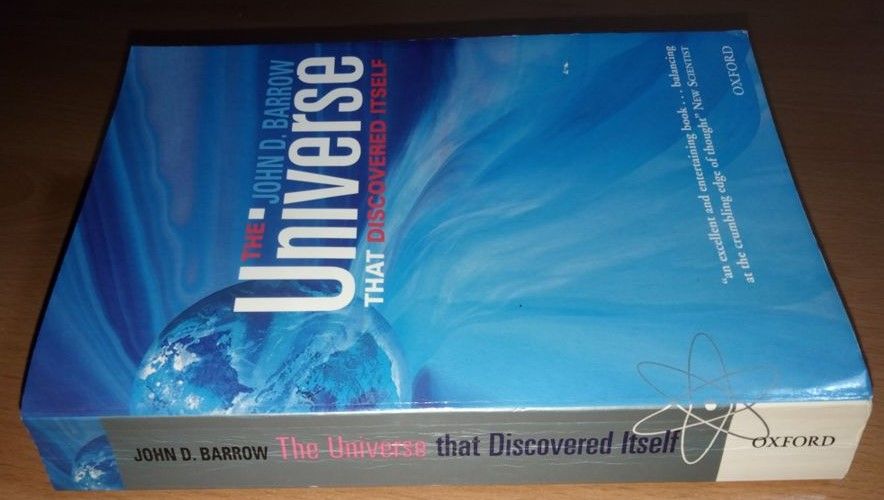One of my favorite popular science book writer is John D. Barrow.
His books focuses on his two academic and research specialties: mathematics and physics. He writes about these matters quite clearly, although in this facet I think there are other authors who elaborate or take more risks to explain complex concepts to a general audience.
What makes Barrow’s style stand out from other scientific writers has more to do for me with two other aspects:
- How it frames what he explains within the history and development of science, and the wise selection of less hackneyed episodes and historical contributions, curious anecdotes or original quotes that make its narrative more attractive.
- His interest in the philosophy of science leads him to analyze scientific theories at a more conceptual level, enriching the context and interpretation of the ideas he is exposing. Where others say: this is no longer my field and here I leave it, he throws himself fully and tries to structure that knowledge to give them, from my point of view, a greater meaning, broader and at the same time deeper.
Barrow has published extensively in the “popular science” genre. It is a catchall label because in addition to books that attempt to explain science to non-specialists, we can find works that present speculative scientific hypotheses and/or extend across diverse fields of knowledge and so they do not fit well under a professional and ‘compartmentalised’ publishing format.
In this line, Barrow is above all known for the book “The Anthropic Cosmological Principle“, written with Frank Tipler, and although I had the opportunity to read it as well as some others of his (Theories of Everything, The Book of Nothing, The Mathematial Universe, The Book of Universes, …) I have selected for this review one that I could get recently: “The Universe that discovered itself” (2000)
This is an updated version of his previous book “The World Within the World” (1997). I have chosen it because, in addition to being less well known, it takes a tour de force through multiple areas of mathematics and physics -which is not unusual in Barrow, although without reaching the extension of the encyclopedic Anthropic Principle- and because of the vision and analysis it carries out at a more philosophical level.
The book includes a lot of topics, but to give an idea I’m going to mention a few (I’ve seen developed some of them in a similar way in other Barrow’s books):
- Reflections on the laws of Nature (focusing especially on physical laws): do they really exist? How can be defined? Are there different types? Why do they work? Could they change over time?….
- Continuing with the interpretation of science and its laws, he explains the different ‘schools’ with their numerous “-isms” and the different visions they hold of reality: empiricism, positivism, operationism,…
- Why science flourished above all at a particular time in Western Europe and not in other contexts such as ancient Greece, China or Arab or Jewish cultures, and how their different worldviews influenced it.
- The nature of Mathematics: can they be defined? What are they? Why do they work in the laws of Nature? He also explains the different approaches or interpretations: platonism, conceptualism, formalism and intuitionism.
Of course, we are going to find the ‘Barrow style’ that sprinkles the book with mentions of little-known scientists, such as William Wells or William K. Clifford, with ideas that were ahead of later great theories; curious stories such as what were the first books to spread science – have you ever heard of “Sir Isaac Newton’s Philosophy explained for the use of the ladies“? – or those ingenious quotations that introduce us into the different sections of the book, such as this one by Chesterton:
“The poet only asks to get his head into the heavens. It is the logician who seeks to get the heavens into his head. And it is his head that splits.”
Perhaps the best description of the book is given by Barrow himself in the preface. I copy its first paragraphs because they express it better than I could:
“In recent years there has been a vast increase in the publication rate of so-called ‘popular’ science books. Regardless of whether they do indeed turn out to be popular with anybody but their author, their common aim has been to explain in simple terms the constant stream of new ideas and discoveries that have emerged in the fundamental sciences during the last dscade. In this book the aim is not simple to pick again upon one of those esoteric fields at the frontiers of fundamental science and attempt to explain it in simple terms. Rather is to pick upon the traditional unspoken assumptions to which we owe all these abstract and pragmatic developments: that the Universe is ordered, that is logical, that is mathematical, that is predictable , that is governed by something outside ouselves which is the same everywhere and everywhen, but which has a deep resonance with the workings of our own minds: to explore something of the origin and possible menings of the idea that there exist ‘laws of Nature’ and some of the unsuspected realms that such an idea had lead us……”
In short, an extensive book (more than 400 pages) that sometimes disperses or becomes somewhat dense -but not difficult- for all that it covers. Even considering that some subjects are well known (it is a work written almost 20 years ago) I believe that because of its approach it is still an interesting and entertaining reading.
For those less familiar with the philosophy of science it can broaden their vision and provide them with a new approach, and for those who like to enter into these analyses (as I do), they will enjoy many of the ideas presented by the author.

Comments